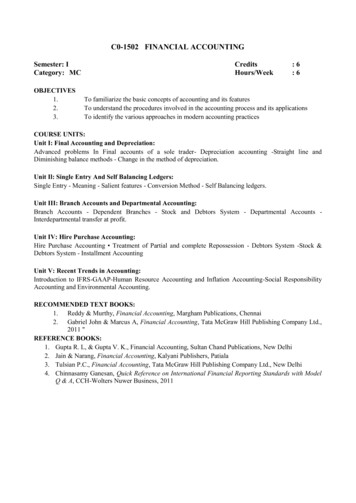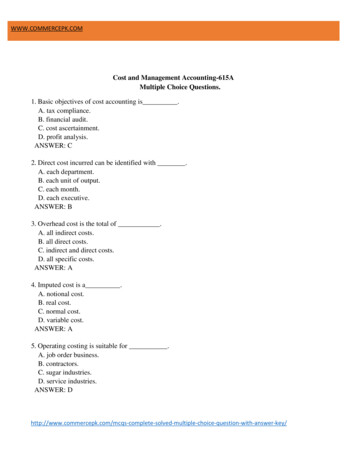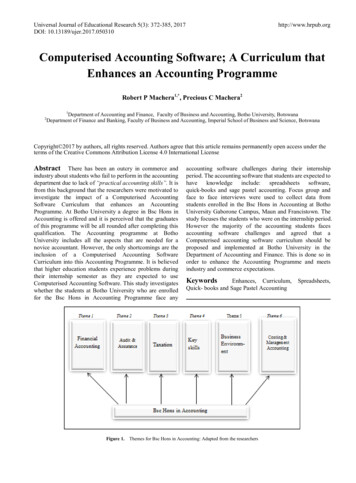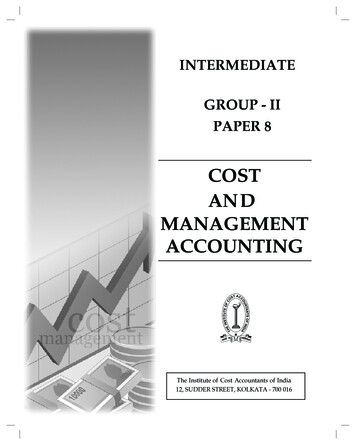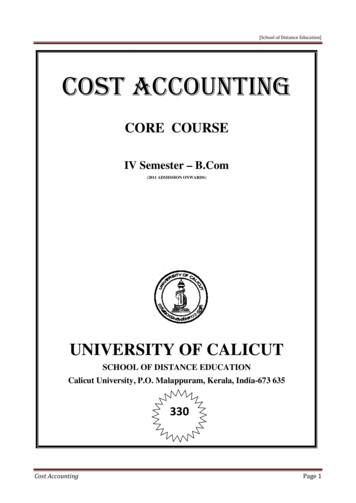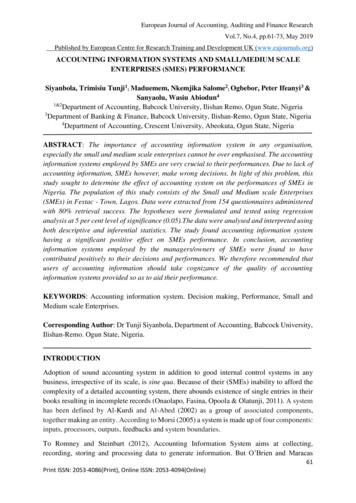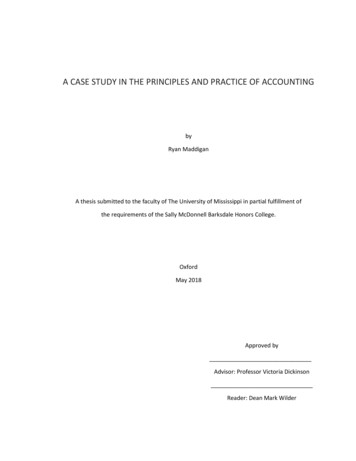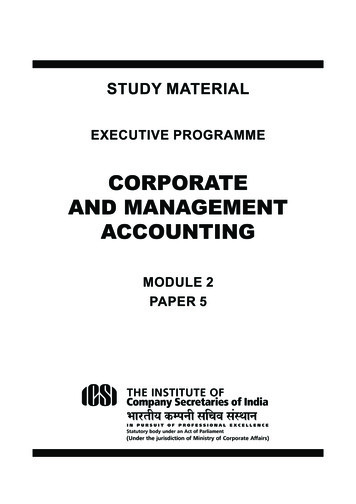
Transcription
STUDY MATERIALEXECUTIVE PROGRAMMECORPORATEAND MANAGEMENTACCOUNTINGMODULE 2PAPER 5i
THE INSTITUTE OF COMPANY SECRETARIES OF INDIATIMING OF HEADQUARTERSMonday to FridayOffice Timings – 9.00 A.M. to 5.30 P.M.Public Dealing TimingsWithout financial transactions – 9.30 A.M. to 5.00 P.M.With financial transactions – 9.30 A.M. to 4.00 P.M.Phones41504444, fo@icsi.eduLaser Typesetting by AArushi Graphics, Prashant Vihar, New Delhi, andPrinted at H T Media/August 2020ii
EXECUTIVE PROGRAMMECORPORATE AND MANAGEMENT ACCOUNTINGIn today’s business world accounting is considered as ‘the universal language of all business’, because it is themedium for reporting financial information about a business entity to users, such as shareholders, banks andmanagers. A proper accounting system is essential to any business, whether big or small, in order to manageits daily functions and run it successfully. The main obligation of any business is to maximize profits, minimizelosses and at the same time maintain its position as a responsible entity within the society.So, in the current business world, everybody should have the knowledge of accounting discipline irrespectiveof the job one is doing. Due to the rapid advancement in business activities due to industrialization andglobalization, the need for people having knowledge of accounts have increased manifold. It is impossible tosurvive in today’s advanced business environment without adequate knowledge of basic accountancy.Especially all business students should have some background in accounting to understand, interpret andpresent the results of business. Keeping this objective in alignment, this study material is prepared to augmentthe basic as well as advanced understanding of students in the related aspects of Corporate and ManagementAccounting.The Study Material which is divided in two parts covers in the details the concepts of Corporate Accounting inPart – I and discusses Management Accounting and Valuation in detail under Part-II.Besides, as per the Company Secretaries Regulations, 1982, students are expected to be conversant with theamendments to the law made up to six months preceding the date of examination.The legislative changes made upto June 30, 2020 have been incorporated in the study material. However, itmay so happen that some developments might have taken place during the printing of the study material and itssupply to the students. The students are therefore advised to refer e-bulletin and other publications for updationof the study material.In the event of any doubt, students may write to the Directorate of Academics of the Institute for clarification atacademics@icsi.edu.Although due care has been taken in publishing this study material, the possibility of errors, omissions and /ordiscrepancies cannot be rules out. This publication is released with an understanding that the Institute shall notbe responsible for any errors, omissions and/or discrepancies or any action taken in that behalf.Should there be any discrepancies, errors or omissions noted in the study material, the Institute shall be obliged,if the same is brought to its notice for issue of corrigendum in the e-Bulletin ‘Student Company Secretary’.The Institute has decided that the examination for this paper under new syllabus from December 2019 sessiononwards to be held in Optical Mark Recognition (OMR) format.iii
EXECUTIVE PROGRAMMECORPORATE AND MANAGEMENT ACCOUNTINGAccounting helps organization in taking management decisions, formation of planning and control system. Italso helps expert advice in financial reporting with formulation and implementation of organizational strategies.A proper accounting system is essential to any business, whether big or small, in order to manage its dailyfunctions and run it successfully. The main obligation of any business is to maximize profits, minimize lossesand at the same time maintain its position as a responsible entity within the society.So, in the current business world, everybody should have the knowledge of accounting discipline irrespective ofthe job one is doing. Due to the rapid advancement in business activities due to industrialization and globalization,the need for people having knowledge of accounting, especially, Corporate and Management Accounting haveincreased manifold in light of the rise in the magnitude of financial transactions and its complexities . Moreover,the business scene is now getting dominated by more of corporate sector than sole proprietorship form ofbusiness exposed to stringent regulatory framewok, which in turn, calls for more scientific approach towardsthe critical financial facets of the business. It is impossible to survive in today’s advanced business environmentwithout adequate knowledge of basic TradeAssociationivDirectors &CEOsEmployeesLineManager
easurement–Business –Entity–Going Concern–Time PeriodAccountingConcepts– RevenueRealisation– Matching– Full Disclosure– Historical Cost– Dual Aspects– Variable andObjective � Materiality– Prudence– Consistency– Cost BenefitIssued By CountryRegulatory BodyThe financial statements are the end products of accounting process. They are prepared following the consistentaccounting concepts, principles, procedures and also the legal environment in which the business organizationsoperate. These statements are the outcome of the summarizing process of accounting and therefore, are thesources of information on the basis of which conclusions are drawn about the profitability, and the financialposition of a company. Hence, they need to be arranged in a proper form with suitable contents so that theshareholders and other users of financial statements can easily understand and use them in their economicdecisions in a meaningful way.The objective of this subject is to make the students understand the statutory provisions regarding preparation offinal accounts of companies. After going through this lesson, one should be able to – Familiarize and understandwith the requirements of preparation of statement of Profit and Loss and Balance Sheet and how to form a trueand fair view of the financial statements.v
Accounting as they are the components of Financial AccountingStep 1Analysis ofBusinessTransactionsStep 2Make JournalEntriesStep 9 PostClosing TrialBalanceStep 3Post toLedgerAccountsStep 8 CloseAccountsStep 4Prepare TrialBalanceStep 7PrepareFinancialStatementsStep 6Adjusted TrialBalanceStep 5 MakeAdjustingEntriesCash flow statement is additional information to the user of financial statement. This statement exhibits cashinflows and outflows and cash equivalents. It assesses the ability of the enterprise to generate cash and utilizecash. Cash Flow Statement is one of the tools for assessing the liquidity and solvency of the enterprise.Accounting Standards (AS) are written policy documents by expert accounting body or by government or otherregulatory body covering the aspects of recognition, measurement, presentation and disclosure of accountingtransactions in the financial statements. The ostensible purpose of the standard-setting bodies is to promotethe dissemination of timely and useful financial information to investors and certain other parties having aninterest in the company’s economic performance. Accounting standards reduce the accounting alternativesin the presentation of financial statements within the bounds of rationality, thereby ensuing comparability offinancial statements of different enterprises.Cost is a measurement, in monetary terms, of the amount of resources used for the purpose of production ofgoods or rendering services. Cost in simple words means the total of all expenses. Cost is also defined asthe amount of expenditure (actual or notional) incurred on or attributable to a given thing or to ascertain thecost of a given thing. Cost is a generic term and it is always advisable to qualify the word cost to show exactlywhat it means, e.g., prime cost and factory cost. Cost is also different from value as cost is measured in termsof money, whereas value in terms of usefulness or utility of an article. Marginal costing is a principle wherebyvariable costs are charged to cost units and the fixed costs attributable to the relevant period is written off in fullagainst the contribution for that period. Marginal costing is the ascertainment of marginal cost and the effect onprofit of changes in volume or type of output by differentiating between fixed costs and variable cost.vi
Management accounting is an applied discipline used in various industries. The specific functions and principlesthey applied vary based on the industry. Management accounting principles in banking are specialized yetdo have some common fundamental concepts which are used whether the industry is manufacturing-basedor service-oriented. For example, transfer pricing is a concept used in manufacturing, but is also applied inbanking. It is a fundamental principle used in assigning value and revenue attribution to various business units.Company secretaries, due to their excellence and depth of knowledge in various corporate and related laws, aswell as in finance and management disciplines and due to their professional training, are entrusted with severalkey functions in the corporate sector. The role of a Company Secretary in different management hierarchy variesfrom the positions held in the organization and the functions looked after by him/her. Company Secretary’sfunctions encompass a wide spectrum of duties and responsibilities, which, if laid down, would be a neverending list. However, for the sake of brevity, some of the important tasks, generally entrusted to a CompanySecretary and satisfactorily discharged by him/her in the Corporate world, are enumerated icerAdvice tothe Board ofDirectorsRole of aCompanySecretaryinCorporatesFormulationof ingsActiveContributoryto CorporateGovernanceLiaison inthe AuditProcessCompany Secretaries also play an important role in the process of conforming to the different statutory/regulatoryrequirements as prescribed by different authorities. Company Secretaries generally take part in the formulationof various corporate policies for approval by the Board of Directors. Threadbare discussions are held by theCorporate Management Team including the Company Secretary, before any policy is firmed up.vii
EXECUTIVE PROGRAMMEModule 2Paper 5CORPORATE AND MANAGEMENT ACCOUNTING(Max Marks 100)SYLLABUSObjectivesPart I : To provide knowledge and understanding of the concepts, principles and practices in CorporateAccounting and Indian and International Accounting Standards.Part II: To acquire knowledge and understanding of the concepts, techniques and practices ofmanagement accounting and to develop skills for decision-making and to acquire knowledge ofthe concepts, principles and methods of valuation.PART ICORPORATE ACCOUNTING (60 MARKS)Detailed Contents1.Introduction to Financial Accounting.2.Introduction to Corporate Accounting : Records of accounts to be maintained by a company.3.Accounting for Share Capital : Issue of Shares; Forfeiture and Reissue of Shares, AccountingTreatment of Premium, Buy-back of Shares; Redemption and Conversion; Capital Redemption Reserve,Bonus Shares; Rights Issue, ESOPs, ESPS, Sweat Equity Shares; and Underwriting; Book Building.4.Accounting for Debentures : Accounting Treatment, Debenture Redemption Reserve, Redemption ofDebentures and Conversion of Debentures into Shares. Deferred Tax.5.Related Aspects of Company Accounts : Accounting for ESOP, Buy-back, Equity Shares withdifferential rights, Underwriting and Debentures.6.Financial Statements Interpretation: Preparation and Presentation of Financial Statements; Quarterly,Halfyearly and Annual Financial Statement pursuant to Listing Regulations;Depreciation provisions andReserves; Determination of Managerial Remuneration, Corporate Social Responsibility spend, variousdisclosures under the Companies Act, 2013, LODR & applicable accounting standards; Related partyand segment reporting, Audit Queries; How to Read and interpret Financial Statements.7.Consolidation of Accounts as per Companies Act, 2013 : Holding Company, Subsidiary Companies,Associate Companies and Joint Venture; Accounting Treatment and disclosures.8.Corporate Financial Reporting : Requirements of Corporate Reporting; Recent trends in FinancialReporting.viii
9.Cash Flow Statements : Preparation and their analysis.10.Accounting Standards (AS) : Applicability, Interpretation, Scope and Compliance; InternationalFinancial Reporting Standards ; Overview of AS, AS vs. Ind AS vs. IFRS.11.National and International Accounting Authorities.12.Adoption, Convergence and Interpretation of International Financial Reporting Standards (IFRS)and Accounting Standards in India.Case Studies & Practical Aspects.PART IIMANAGEMENT ACCOUNTING AND VALUATION (40 MARKS)13.An Overview of Cost: Importance and relevance of Cost Accounting Material Cost, Labour Cost,Direct Expenses and Overheads, Cost Sheet.14.Cost Accounting Records & Cost Audit under Companies Act, 2013.15.Budget, Budgeting and Budgetary Control: Preparation of various types of Budgets; BudgetaryControl System; Zero Based Budgeting; Performance Budgeting.16.Ratio Analysis: Financial Analysis through Ratios.17.Management Reporting (Management Information Systems).18.Decision Making Tools: Marginal Costing; Transfer Pricing.19.Valuation Principles & Framework: Conceptual Framework of Valuation, Valuation rules; Valuationof securities or financial assets; Approaches of Valuation - Assets Approach, Income Approach; MarketApproach; Registered Valuer; IND AS Valuation.20.Valuation of Shares, Business and Intangible Assets: Regulatory Valuations; Companies Act;Insolvency and Bankruptcy Code; Income Tax Act; SEBI law; FEMA and RBI guidelines.21.Accounting for Share-Based Payments (Ind AS 102).22.Methods of Valuation: Net Assets Valuation: Relative Valuation (Comparable Companies/Transactions); Discounted Cash Flow Valuation; Other Methods.Case Studies & Practical Aspects.ix
LESSON WISE SUMMARYCORPORATE & MANAGEMENT ACCOUNTING1. Introduction to Financial AccountingAccounting is a very old concept – as old as money. A description of proper keeping of accounts is also found in‘Arthashastra” written by Kautilya. However, it has developed with the passage of time to meet the requirementsand challenges of ever – growing society. The modern-day accounting concept based on double entry systemwas originated by Luco Pacioli in Italy. Though the act of accounting is very old, in recent times it has acquiredspecial significance because of rapidly growing economy, cut-throat competition, expanding markets andincreasing production and changes in technology.In this lesson, we will throw light on the basic concepts of accounting, types of accounts, accounting principles,conventions, concepts & accounting standards, meaning of double entry system and the rules of debit & crediton which the entire concept of accounting is based.Accounting process involves identification and analysis of financial transactions. These transactions arerecorded, classified and summarised in a systematic manner to give useful information. Thus, accountingprocess starts with the recording of business transactions in monetary terms, in the primary books of accounts.For recording business transactions, it is necessary that these transactions are evidenced by proper sourcedocuments like cash memoes, purchase bills, sales bills, counterfoils of cheques issued, salary slips etc. Fromthese source documents, transactions are recorded in the books of accounts which are the first and majorstep in accounting. It is the basis of accounting as entire future process would depend upon this recording oftransactions. In this lesson, we will know about recording transactions in primary books like Journal and othersubsidiary books, posting in ledger and then preparation of trial balance.2. Introduction to Corporate AccountingThere is no legal obligation for sole proprietorship and partnership firm to prepare final accounts, but companieshave statutory obligations to keep proper books of account and to prepare its final accounts every year in themanner as prescribed in the Companies Act. Chapter IX, Sections 128 to 138 of the Companies Act, 2013deals with the legal provisions relating to the Accounts of Companies. Final accounts of a company consist ofbalance sheet as at the end of the accounting period and profit and loss account for that period. Section 129 ofthe Companies Act, 2013 prescribes the form and contents of balance sheet and profit and loss account of acompany. Balance sheet of a company shall be prepared according to Schedule III of the Companies Act, 2013.The Schedule III sets out the minimum requirements for disclosure on the face of the Balance Sheet, and theStatement of Profit and Loss (hereinafter referred to as “Financial Statements”) and Notes. Statement of Profit& Loss of a company shall be prepared according to Part II of Schedule III of the Companies Act, 2013. Section129(1) of the Companies Act 2013, states that the financial statements shall give a true and fair view of the stateof affairs of the company or companies, comply with the accounting standards notified under section 133 andshall be in the form provided for different class or classes of companies in Schedule III.3. Accounting for Share CapitalThe most striking feature of a company is its ownership structure. The capital in a company is divided into smallshares of fixed value. The shares of a company may be equity shares or preference shares. The objective ofx
this lesson is to make students aware about accounting of different aspects of share capital. After studying thislesson one should be able to:–Understand the share capital structure in the balance sheet of a company.–Discuss the methods and accounting procedure of issue of shares.–Specify the accounting treatment when shares are issued at par, premium and at discount.–Explain the meaning and accounting treatment of forfeiture of shares and reissue thereof.–Understand the accounting procedure of buy-back of shares.–Enumerate the steps for redemption of preference shares.–Appreciate the purpose of issuing Right shares & Bonus shares.–Understand the accounting treatment for ESOPs, ESPS, Sweat Equity Shares.–Understand the meaning of underwriting.–Familiarize with various types of underwriting.–Distinguish between marked application and unmarked applications.–Determine the liability of underwriters.4. Accounting for DebenturesEquity sources of financing are however not always sufficient to meet the ever growing needs of the corporateexpansion and growth. Hence, corporates turn to debt financing through financial institutions, commercial banksor by issuing debt instruments either through the route of private placement or by offering the same for publicsubscription. Owing tax shield provided by debt instruments, the debt financing not only helps in reducing thecost of capital but also helps in designing appropriate capital structure of the company. This lesson deals withthe accounting treatment of different aspects of debenture and bond especially with issue, redemption includingconversion of debenture.5. Related Aspects of Company AccountsThe objective of this lesson is to make students aware about accounting of different aspects of share capitaland deals with the accounting treatment of different aspects of debenture and bond especially with issue,redemption including conversion of debenture. Understand the share capital structure in the balance sheet ofa company. Discuss the methods and accounting procedure of issue of shares. Understand the accountingprocedure of buy-back of shares. Understand the accounting treatment for ESOPs and ESPS. Understand themeaning of underwriting Familiarize with various types of underwriting. Distinguish between marked applicationand unmarked applications. Determine the liability of underwriters. State the meaning of debenture and bonds;Describe the methods for the issue of debenture for cash and for consideration other than cash; Explain theissue of debenture as a collateral security; Explain the sources and record transaction relating to redemption ofdebenture; Discuss the methods of redemption of debenture; Record the Sinking Fund Investment transactions;Deal with cum-interest and ex-interest, open market operations.6. Financial Statements InterpretationFinancial statements are compilation of financial data, collected and classified in a systematic manner accordingto the accounting principles, to assess the financial position of an enterprise as regards to its profitability,operational efficiency, long and short – term solvency and growth potential.Financial statements are basic and formal means through which management of an enterprise make publiccommunication of financial information along with select quantitative details. They are structured financialrepresentation of the financial position, performance and cash flows of an enterprise. Many users rely onxi
the general purpose financial statements as the major source of financial information and therefore, financialstatements should be prepared and presented in accordance with their requirement. That does not underminethe dependence of the general users on the information contents of the financial statements.7. Consolidation of Accounts as per Companies Act, 2013A holding company is one which acquires all or a majority of the equity shares of any other company calledsubsidiary company in order to have control over the subsidiary company. In order to understand the financialposition of holding company, consolidations of accounts become very vital. After studying this lesson you willbe able to:–Understand the concept of holding company and subsidiary company.–Familiarize the legal requirements for preparation of final accounts of holding company.–Prepare consolidated balance sheet and statement of profit and loss.–Make appropriate accounting adjustments required for the preparation of consolidated balance sheet.–Understand the concept of minority interest in consolidation of accounts.–Appreciate the treatment of pre-acquisition profits and losses of the subsidiary company. Makeadjustment regarding profit and loss on revaluation of assets of subsidiary company.–Understand the calculation of goodwill or cost of control.–Make adjustment for inter-company unrealized profits and inter-company transactions.–Understand the treatment of bonus issue on consolidation of accounts.–Make adjustment on dividend received from subsidiary company.8. Corporate Financial ReportingAccounting is a process to identify measure and communicate economic information to form informed judgmentsand decisions by the user of the information. Its function is to provide quantitative information, primarily financialin nature, about economic entities, that is intended to be useful in making economic decisions and relatedchoice among alternative course of actions. Financial reporting may be defined as communication of publishedfinancial statement and related information from a business enterprise to all its users. It contains both qualitativeand quantitative information.The Financial Report made to the management is generally known as Internal Reporting, while financialreporting made to the shareholder investors/management is known as external reporting. The internal reportingis a part of management information system and uses MIS reporting for the purpose of analysis as an aid indecision making process.The management of a corporate is ultimately responsible for the generation of accounting information. Theaccountability of a company has two distinct aspects – legal and social. Under legal requirements a companyhas to supply certain information to the various users through annual reports and under the social obligation, acompany has to provide additional information to various user groups9. Cash Flow StatementsCash flow statement is additional information to user of financial statement. This statement exhibits the flow ofincoming and outgoing cash and cash equivalent. It assesses the ability of the enterprise to generate cash andutilize cash. Cash Flow Statement is one of the tools for assessing the liquidity and solvency of the enterprise.Cash Flow Statement is considered to be a summarized statement showing sources of Cash Inflows andxii
application of cash outflows of an enterprise during a particular period of time. It is prepared on the basis of thepublished data as disclosed by the Financial Statement of two different financial periods. It is an essential toolfor managerial decision-making. Cash Flow reports the management Net Cash Flow (i.e. cash inflow less cashoutflow or vice versa) from each activity of the enterprise as well as of the overall business of the enterprise. Themanagement of the enterprise gets a picture of movement of cash resources from the Cash Flow Statementand can assess the stronger and weaker area of movement of cash for different activities of the business fordrawing up the future planning.10. Accounting Standards (AS)Accounting Standards (AS) are written policy documents by expert accounting body or by government or otherregulatory body covering the aspects of recognition, measurement, presentation and disclosure of accountingtransactions in the financial statements. The ostensible purpose of the standard setting bodies is to promotethe dissemination of timely and useful financial information to investors and certain other parties having aninterest in the company’s economic performance. Accounting standards reduce the accounting alternativesin the presentation of financial statements within the bounds of rationality, thereby ensuing comparability offinancial statements of different enterprises.11. National and International Accounting AuthoritiesUnder this unit we will study various national and international accounting authorities. Under national accountingauthorities will study The Institute of Company secretaries of India (ICSI), The Institute of Chartered Accountantsof India (ICAI), The Institute of Cost Accountants of India. Under International Accounting authorities we willstudy: IFRS Foundation/ International Accounting Standards Board (IASB) , The International Public SectorAccounting Standards Board (IPSASB), Financial Reporting Council (FRC) (UK), European Financial ReportingAdvisory Group (EFRAG), Financial Accounting Standards Board (FASB), American Institute of Certified PublicAccountants (AICPA), Australian Accounting Standards Board (AASB), The Chartered Accountants Australiaand New Zealand, Financial Reporting & Assurance Standards Canada, Canadian Institute of CharteredAccountants (CICA), Accounting Standards Board of Japan (ASBJ), External Reporting Board (XRB),NewZealand, New Zealand Institute of Chartered Accountants.12. Adoption, Convergence and Interpretation of International Financial Reporting Standards(IFRS) and Accounting Standards in IndiaAccording to International Accounting Standard Board (IASB) conceptual framework, the objective of generalpurpose financial reporting is to provide financial information about the reporting entity that is useful to existingand potential investors, lenders and other creditors is making decisions about providing resources to the entity.Consequently, the two important characteristics of financial information that emanates from the above objectiverelates to relevance and reliability. According to IASB Framework for the Preparation and Presentation ofFinancial Statement, information is deemed to be relevant when it influences the economic decisions of usersby helping them evaluate past, present or future events or confirming or correcting, their past evaluations.Similarly to be reliable, information must represent faithfull the transactions and other events it either purportsto represent or could reasonably be expected to represent.13. An Overview of CostCost is a measurement, in monetary terms, of the amount of resources used for the purpose of production ofgoods or rendering services. Cost in simple, words, means the total of all expenses. Cost is also defined as theamount of expenditure (actual or notional) incurred on or attributable to a given thing or to ascertain the cost ofa given thing. Thus it is that which is given or in sacrificed to obtain something. The cost of an article consistsof actual outgoings or ascertained charges incurred in its production and sale. Cost is a generic term and it isxiii
always advisable to qualify the word cost to show exactly what it meant, e.g., prime cost, factory cost, etc. Costis also different from value as cost is measured in terms of money whereas value in terms of usefulness or utilityof an article.14. Cost Accounting Records & Cost Audit under Companies Act, 2013Cost Audit involves an examination of cost books, cost accounts, cost statements and subsidiary and primedocuments with a view to satisfying the auditor that these represent true and fair view of the cost of production.This includes the examination of the appropriateness of Cost Accounting system.Cost Audit is an innovation introduced for the first time in the world and India with a view to regulateindustries on healthy and sound lines. It is for cost-effective products and services to customers, properrevenue to government’s treasury and proper returns to other stakeholders of the enterprise. India is thefirst country in the world introducing the legal prov
Accounting helps organization in taking management decisions, formation of planning and control system. It also helps expert advice in financial reporting with formulation and implementation of organizational strategies. A proper accounting system is essential to any bus




